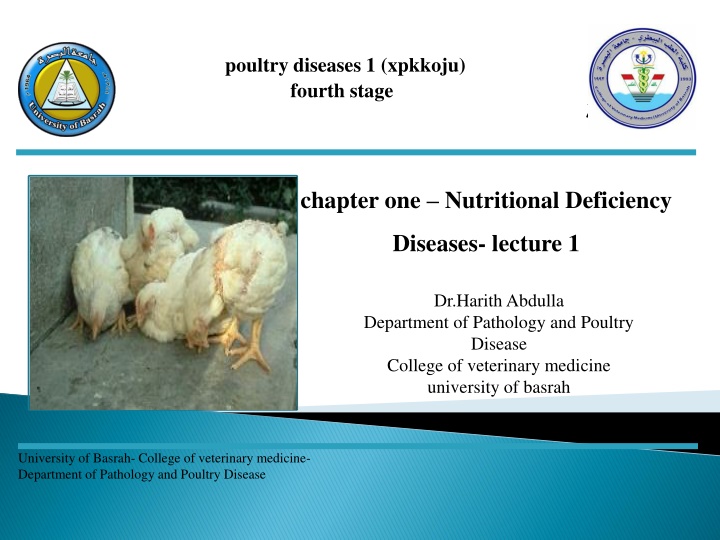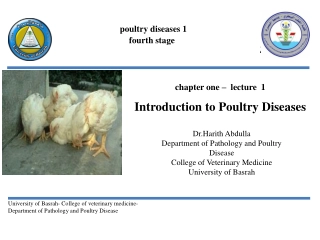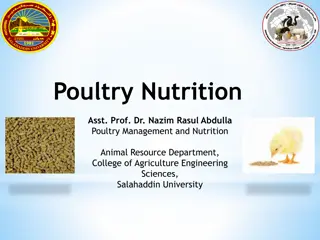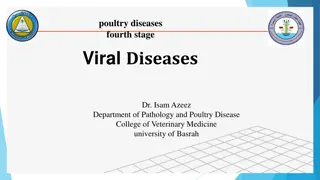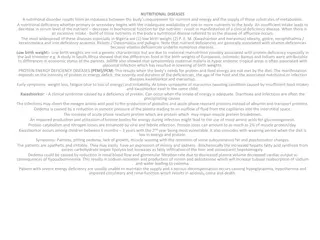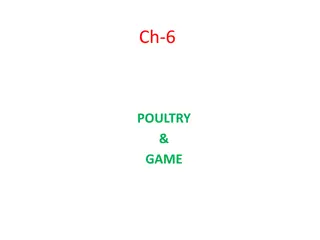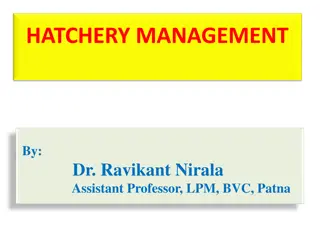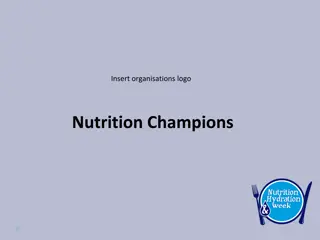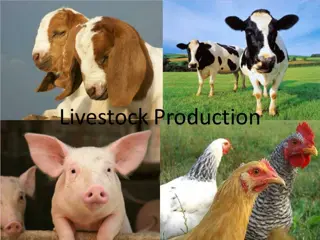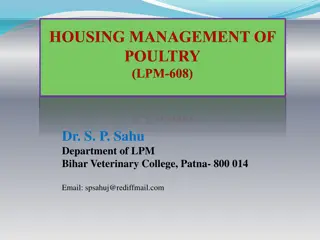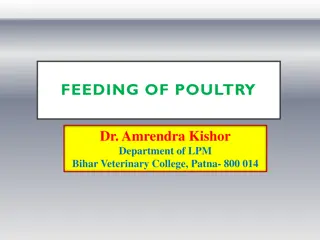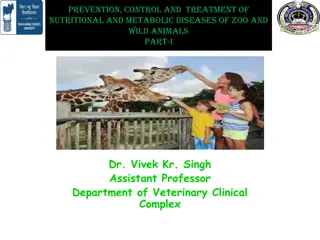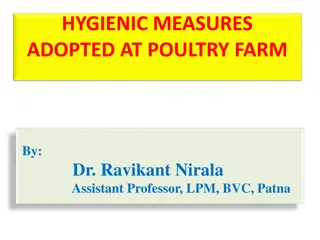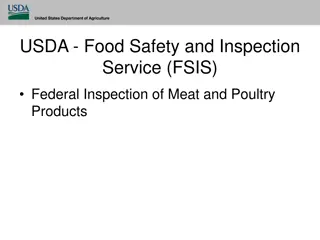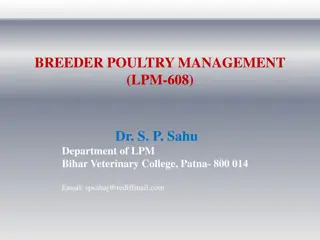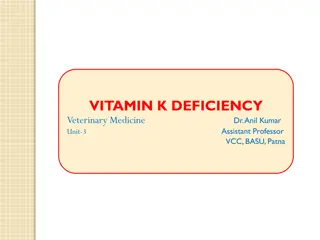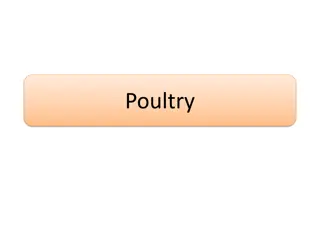Poultry Nutritional Deficiency Diseases
Poultry are kept worldwide for meat and egg production. Nutrient deficiencies, infectious agents, and environmental conditions can lead to diseases. Symptoms include feather loss, inactivity, abnormal droppings, and more. Vitamins play a crucial role in poultry diets, with fat-soluble vitamins stored longer than water-soluble ones. Vitamin A deficiency can result from inadequate dietary levels or interactions with certain antibiotics.
Download Presentation

Please find below an Image/Link to download the presentation.
The content on the website is provided AS IS for your information and personal use only. It may not be sold, licensed, or shared on other websites without obtaining consent from the author.If you encounter any issues during the download, it is possible that the publisher has removed the file from their server.
You are allowed to download the files provided on this website for personal or commercial use, subject to the condition that they are used lawfully. All files are the property of their respective owners.
The content on the website is provided AS IS for your information and personal use only. It may not be sold, licensed, or shared on other websites without obtaining consent from the author.
E N D
Presentation Transcript
poultry diseases 1 (xpkkoju) fourth stage chapter one Nutritional Deficiency Diseases- lecture 1 Dr.Harith Abdulla Department of Pathology and Poultry Disease College of veterinary medicine university of basrah University of Basrah- College of veterinary medicine- Department of Pathology and Poultry Disease
Poultry are kept all over the world for various reasons. They are one of the cheapest sources of meat and can be kept by anyone. Poultry are kept by large commercial farmers for meat or egg production, by smaller farmers and by house holds in backyards. When chickens are healthy they eat less food and produce more meat and eggs. They are less trouble to look after and less money is spent on medical costs.
A pathological condition of a body part, an organ, or a system resulting from various causes, such as infection, genetic defect, or environmental stress, and characterized by an identifiable group of signs or symptoms. Causes of disease Nutrient Deficiencies Infectious agents Environmental conditions
feather loss (unless birds are going through a natural moult) general inactivity discharges abnormal droppings dull and/or closed eyes ruffled feathers drooped wings sitting on haunches or lying down.
Vitamins ? The amounts of various vitamins needed in poultry diets are very low. The vitamins function as cofactors for enzymes, hormones (e.g., vitamins A, D), or antioxidants (vitamin E).
The fat-soluble vitamins A, D, ,k and E are stored relatively well and birds can with stand long periods of depletion before deficiency symptoms manifest. Water-soluble vitamins are not stored to a large extent, excesses are excreted mostly in urine, and they are relatively nontoxic.
is required for the health of the membranes of the digestive, urinary, reproductive and respiratory systems. A vitamin A deficiency can result when the level in the diet is inadequate or the vitamin added to the diet is oxidized by rancid fat in the diet. Additionally, neomycin, a common antibiotic, decreases the absorption of vitamin A. Vitamin A is a fat-soluble vitamin and an inadequate level of fat in the diet could also limit its absorption, even if in the diet at adequate levels.
Vitamin A deficiency in the embryo results in a grossly abnormal cardiovascular system, characterized by an absence of vascular networks. In chickens and turkeys (insufficient vitamin A during 1-7 weeks of age). As in the case of other nutritional deficiencies, classic signs of deficiency are very rare in commercial poultry fed complete diets.
Vitamin A is essential in poultry rations for: a- Growth. b-Optimum vision. c-Maintaining the integrity of the mucous membrane. General Signs 1-Poor growth. 2-Poor feathering. 3-Drowsiness. 4.Off food. 5-Pale comb and wattles.6-Rough feathers.
1-Watery nasal and ocular discharge. 2-Eyelids stuck together with thick milky exudates. 3-Decrease egg production. 4-Increase embryonic mortality. 5-Ataxia. 6-Xerophthalmia. 7-Caseous material under the eyelids.
Because epithelial linings of alimentary, urinary, genital, and respiratory systems are composed of mucous membranes, these are the tissues in which lesions of vitamin A deficiency are most readily observed as: 1-Eyelids inflamed and adhered. 2-Excessive urates in kidneys and ureters. 3-Pustules in mouth and pharynx. 4-Enlarged gall bladder. 5-Small ulcers at the site of the lesions.
1-Atrophy of cytoplasm and loss of cilia in the columnar ciliated epithelium of the respiratory tract . 2-Respiratory epithelium transformed into stratified squamous keratinized epithelium. Diagnosis: 1- Feed formulation. 2-Signs. 3-Lesions. 4-Histopathology. Diagnosis:
Differential diagnosis: 1-Infectious coryza. 2-Chronic fowl cholera. 3-Infectious sinusitis. 4-Avian pox. 5-Trichomoniasis. 6-Thrush. Prevention: Supplementation of diet with vitamin A. Treatment: vitamin A in drinking water Differential diagnosis: Treatment:
